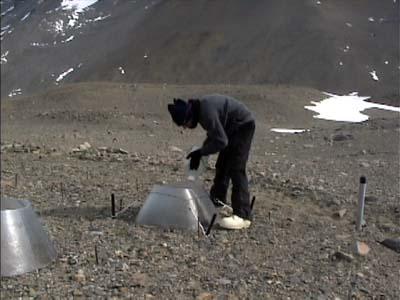
|
|
18 January, 2001
Andy, Allison and I stop our winding trek, setting the six containers of
water down outside of a warming chamber site. The site consists of a grid
marked out in the soil. This site is a 5 x 5 meter grid each consisting of
5 rows that are divided into 5 1x1 meter boxes. Ten inch iron nails have
been set into the soil to mark all of the individual box corners. Out of
the 25 boxes, 12 are covered with warming chambers and 13 are without
chambers.
Allison and I start transferring 5.6 liters of water to one of the empty
watering jugs also hauled from the helo pad. Andy then uses the watering
jug to apply water to a specific plot that does not have a warming chamber.
For every plot watered there is a plot, right next to it that is not
watered. A comparison of the two plots is made over years. Andy explains
to me that the water remains in the soil for only seven days. Even with
the water present for such a short period of time the data indicates that
the watered plots have a higher moisture content than the non-watered
plots. Since the nematodes tend to be more active when the soils have a
certain amount of moisture present, the higher moisture content of the
soils could, in time, lead to shifts in biological activity within the
soils.

Watering the plots at Lake Hoare.
Contact the TEA in the field at
.
If you cannot connect through your browser, copy the
TEA's e-mail address in the "To:" line of
your favorite e-mail package.
|
